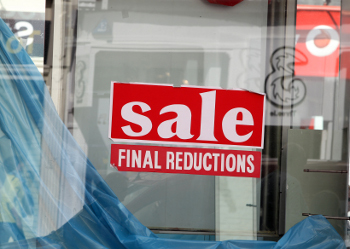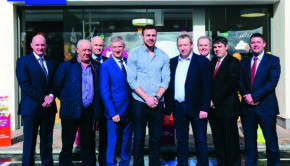Position vacancy

In the run-up to last month's local elections, Retail Ireland urged new councillors to consider the impact exerted by onerous rates burdens on our high streets' shop unit vacancy rates. Gillian Hamill spoke to retailers in some of the worst affected areas to hear how their businesses have been affected and what can be done to tackle this unsightly blight
12 June 2014

Vacancy rates: Nationwide snapshot
According to research conducted by property consultants CBRE:
- Athlone has a vacancy rate on its high street of 21.6% in Q1 of 2014, up from 18.2% in Q3 of last year.
- The vacancy rate on Patrick St in Cork is up from 13% to 14.3%.
- Sligo’s high street vacancy rate stands at 12.5%, unchanged from last year.
- Limerick’s rate also remains unchanged at 16.3%.
- Henry St in Dublin has a vacancy rate of 12.8%, up from 4.3%
Faced with ongoing stiff competition from modern out-of-centre complexes which offer free parking, independent retailers in town centres rely upon two key factors to attract much needed custom. Namely, a convivial atmosphere, and a varied mix of different types of units. Unfortunately, Ireland’s unacceptably high level of vacant units on high streets across the country is doing nothing to bolster either of these areas.
Retail Ireland recently capitalised on the local elections held on Friday, 23 May, by asking newly elected councillors to address the high level of vacant units on streets in Ireland’s towns and cities. The Ibec group urged candidates to remember that the retail industry is the biggest employer in the country and as such, is vital to the success of local economies – a fact which needs to be reflected in the decisions and priorities of local government.
Vacancy rates stubbornly high
Stephen Lynam, Retail Ireland director said: “Research from CBRE shows that while retail activity has picked up a little, vacancy rates in key towns and cities remain high. There are improvements in parts of the country, with high profile areas like Grafton Street showing reduced vacancies and Cork’s Opera Lane development fully let. But the overall picture highlights the continued problems of the sector.”
CBRE associate director Suzanne Barrett has also pointed to a divide between the situation in Dublin and provincial high streets, commenting on its latest vacancy counts for Q1 2014: “Although there have been signs of improvement emerging in the Irish retail sector over the last six month period, much of this recovery is being experienced in the Dublin market or in key shopping centres and retail schemes. The improvement is not yet filtering down to provincial high streets…The extent of vacancy on many high streets around the country is unchanged since our counts were last conducted six months ago.”
 Retail Ireland director Stephen Lynam believes reducing rates for retailers and even offering rates holidays for retailers that take on a vacant unit, will help breathe new life into Ireland’s towns and cities
Retail Ireland director Stephen Lynam believes reducing rates for retailers and even offering rates holidays for retailers that take on a vacant unit, will help breathe new life into Ireland’s towns and citiesTackling the rates burden
The high level of local authority charges, such as commercial rates, was sited as a key problem by Lynam, who prior to last month’s local elections, urged candidates to “remember that a recovery in the retail sector will reduce vacancy rates, increase the rates base and ultimately provide extra funding for local authority services”. This could be achieved, he said, by reducing rates for retailers and even offering rates holidays for retailers that take on a vacant unit. “That way we can breathe new life into our towns and cities,” he added.
Of course, while rates are a significant burden for many retailers, rents certainly haven’t plummeted to the troughs that Ireland’s recession doom mongers would have us believe. In fact, the newspapers’ commercial property pages paint a very different picture. The Irish Times reported last month that the Woodstown Village Centre at Knocklyon, Dublin 16, which was sold during the property boom in 2006 for more than €8 million, had now been sold again, this time for over €3.8 million. The centre reportedly produces a rent roll of approximately €400,000, with 12 units in total (although two remained unlet at the time). It’s anchored by a Spar store which pays a rent of €105,000 – a hefty chunk of change in anyone’s book!
Rent rolls still significant
Meanwhile, in Dublin city centre, it was reported that one of the key retail blocks in Dublin’s Temple Bar area with a range of restaurants including Elephant & Castle, will be offered for sale with a guiding price of €7.8 million for 12 retail buildings, producing a rent roll of €583,000. It is interesting to view the rents of each property for comparison purposes. The largest rent of €160,000 (for nearly 1,500 sq ft on the ground floor and 900 sq ft in the basement) is paid by the restaurant and bar, Elephant & Castle. Gallagher’s Boxty House is next, paying €120,000 for a slightly smaller premises, while the other tenants include Abrakebabra (€65,000), Gondola (€58,000), Pablo Picante (€50,000), Forbidden Planet (€45,000), Mark Cheung (€40,000), Eden Recruitment (€30,000) and Irish Citylink (€15,000).
Elsewhere in the country, it’s no surprise to learn that you can gain considerably more bang for your buck in terms of floor space but rents will still account for a major part of your budget. For example, a development for sale in Limerick city centre last month contained six retail units with an overall floor area of 80,000 sq ft. One of these units (Pet Mania) is reportedly currently let for €73,500 per annum. Naturally, if start-up businesses are being asked to pay such handsome rents, they will expect a guaranteed amount of footfall, which won’t be aided by the prospect of vacant premises nearby.
Athlone analysis
According to CBRE’s research, Athlone recorded a significant vacancy rate on its high street of 21.6% in Q1 of 2014, up from 18.2% in Q3 of last year. Emmet Dooley of family-run business Athlone Flowers has experienced the town’s vacancy rate from two perspectives – as an existing retailer in Athlone and also as the landlord of a vacant unit for which he has been unable to secure a tenant as yet. He told ShelfLife that their failure to rent out a 1,500 sq ft premises on Connacht Street, was “not due to the lack of trying. We have a good relationship with an auctioneer in Athlone here, but just no solid concrete lead on it. Anybody that has come is looking for ridiculous deals like three months’ free rent and knocked down rent prices; it’s very, very demanding, it wouldn’t be viable.” While he has a positive outlook and believes Athlone’s retail offering can cater for all ages, he adds: “The problem in Athlone is that it’s a very spread out town. It goes from Monkstown in the west over to the Dublin Road area in the east and apart from the Golden Island Centre, there [is no defined centre] and that’s why you have all the empty units.”
Dooley says he has “a very good relationship with Athlone Town Council” and that the problem is not the fault of the council. He nevertheless concedes that the current level of rates is “a big burden,” commenting that the rates for his 1,500 sq ft vacant unit is approximately €2,500 – an important consideration for any would-be tenant.
Potential solutions
Parking is another issue, he explains. “The Golden Island centre offers 1,000 free parking spaces and then Athlone Town Council does have a paid parking scheme in operation. You have to understand that they need that further income, it’s a source of revenue for them, but I suppose they could look at maybe giving a half hour free to encourage people to park on a traditional street, like Connacht Street.”
When asked what he sees as a potential solution to Athlone’s high level of vacancies on prominent streets such as Church Street, he shares the idea put forward by a friend of his who also works in retail, “that there should be no more new builds for commercial units on the outskirts of town until the centre of the town is filled first of all; no permission should be given to a new greenfield site”.
Rosie Boles, managing director of traditional department store, Burgess on Athlone’s Church Street, also makes the point that a more “cohesive plan” should be adopted to combat the problem, as while out-of-town outlets have managers that can co-ordinate rents, that on a high street, small units are often each managed by individual landlords.
Cork site released soon
Another vacancy rate which has increased, according to CBRE’s research, is on Cork’s Patrick Street, where the rate has gone up from 13% to 14.3%. ShelfLife spoke to the Lord Mayor of Cork city, Catherine Clancy, who had some positive news to report with regards to vacancies. “We hope to have movement within the next couple of weeks on one of the most prominent vacant units which is a very significant site, the Capitol Cinema site [on Grand Parade] and hopefully that should be released on to the market from Nama in the coming weeks. That has been a priority for this council to get released…The owner of that property had purchased a lot of small shops around it and that really skews the figures for the whole of the city centre.”
When asked what she thinks might potentially fill that unit, she replies that Cork City Council have been considering an expansion of the English Market, which is what she personally would like to see. “There’s a big market for food produced or sold in the market…There’s a very successful restaurant in the market already, The Farmgate, but it’s only open when the market is, so there’s definitely a demand there for that produce as part of a restaurant or some type of an eating emporium.”
Right retail mix
Selling the message that Cork city centre offers an experience which you can’t just find on any other high street or shopping centre, is an important focus for the Lord Mayor. “I think one of the challenges for the city centre, is the challenge presented by [out-of-town] outlets and what we have done and I have done as Lord Mayor, is actually saying when you come to the city centre, you’re not coming into a retail unit, you’re coming into a different experience altogether and what we have to do is sell that message, we have 600 independent units within the city centre…We hold 24 festivals in the year to bring people into the city centre to support tourism.” She adds that there are currently two cruise liners carrying 8,000 people coming into Cork city, and the council is working on ensuring they come into the city centre first, before immediately heading off to destinations such as Killarney and the Cliffs of Moher. “We have a group on Cork City Council called Team that works very strongly on supporting people coming into the city but the main thing is that the Cork people come in themselves, and on an ongoing basis we’re working on that.”
Popping up
She adds that pop-up shops can be a “brilliant” solution to the vacancy problem and that temporary leases, such as for Christmas traders, are another viable option. However she adds that it’s important to secure the right retail mix. “Charity shops are fantastic but we don’t want them everywhere…We’re very fortunate, we have big names like Brown Thomas, Debenhams, Marks and Spencer, and Penneys on our main street. Definitely, you have to have a mix with those main retailers and then you need something as well that makes it individual and different; traditional retailers such as Fitzgerald’s and Keane’s. As Lord Mayor I have been acknowledging that throughout the year, particularly companies that have been on Cork’s Patrick Street, going back 20/30 years.”
It is certainly positive news to hear that Cork’s Capitol Cinema should soon be released on to the market. Elsewhere, now is the ideal time to strike while the iron is hot and ensure your newly elected local representatives are working for you on this vital issue.



 Print
Print






Fans 0
Followers